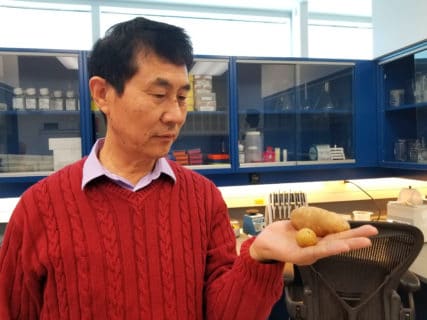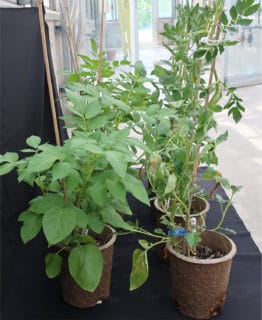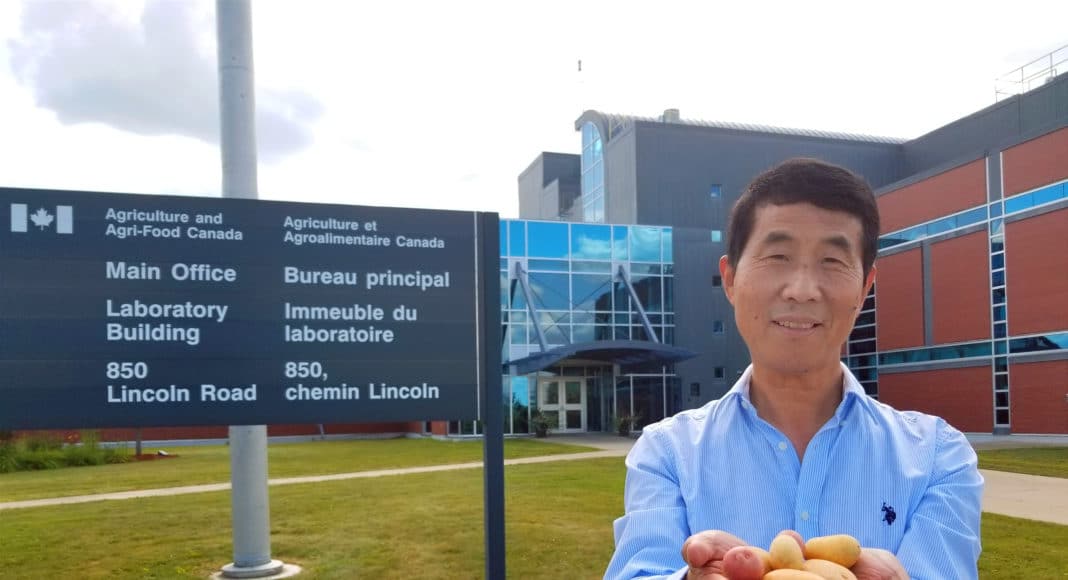[deck]As climate warming turns up the heat, how will Canadian potato production be affected?[deck/]
“Potato crops are known to be sensitive to high temperatures,” says Xiu-Qing Li, a research scientist at Agriculture and Agri-Food Canada’s (AAFC) Fredericton Research and Development Centre. “Potatoes evolved high in the Andes of South America where conditions are relatively cool. So, they grow best at temperatures around 22 degrees Celsius, which makes Canada a great place for potato production,” he says.
“But climate warming has already caused some very hot days in Canada. The highest temperatures recorded in most Canadian provinces in recent years were around 35 C or higher.”
That’s why Li and his research team have been examining how heat stress affects the growth, development and productivity of Canadian potato varieties. Their findings so far show rising temperatures could be a serious issue. The big question on researchers’ minds is how do we help our potato crops beat the heat?
EVALUATING VARIETAL RESPONSES
Li and several colleagues recently published the results from their greenhouse study where they assessed the effects of heat stress on 55 Canadian potato varieties.
One set of the 55 cultivars was grown under a high-temperature regime of 35 C during the day and 28 C at night, and a second set was grown under ideal conditions of 22 C during the day and 18 C at night. The researchers measured plant height and leaf size, leaf chlorophyll content, and weight of the largest tuber.
Until this study, very little was known about the responses of Canadian varieties under high-temperature conditions.

“We have performed the first-ever large-scale evaluation of potato varieties for their tolerance to heat stress,” says Li. His study included two replicates of each of the two treatments, and four plants of each variety within each replicate, for a total of 880 plants, which generated lots of useful information.
“We have identified the relative heat tolerance and susceptibility of the 55 varieties. We found significant variation in heat-stress responses among the varieties,” he says.
“We demonstrated that most of the cultivars — even the relatively heat-tolerant ones — are very sensitive to heat stress. Overall, the plants grown under the high-temperature regime had much smaller leaves, taller plant heights, higher estimated chlorophyll contents, and severely reduced tuber weights.
“The cultivars that were relatively heat tolerant in terms of having the highest tuber weights, also had greater plant height and higher chlorophyll content under heat-stress conditions, compared with the control plants.”
TUBER PRODUCTION DRASTICALLY REDUCED
The most concerning finding is that heat stress dramatically decreased tuber formation and tuber weight in all 55 varieties. On average, the weight of the largest tuber was 93 per cent lower under the high-temperature conditions compared with ideal conditions.
The varieties that performed best in terms of tuber weight under high temperatures were Eramosa, Chieftain, AC Belmont, and Superior. And even Eramosa, the most heat tolerant, had a 70 per cent reduction in tuber weight.
The worst performers were Russet Burbank, All Blue, Butte, AC Chaleur and White Rose. Under heat stress, the All Blue, Butte, AC Chaleur and White Rose plants produced no tubers at all. Out of the eight Russet Burbank plants grown under heat-stress conditions, only one plant produced any tubers, and it had just one little tuber weighing about one gram.
“Under normal growing conditions, when a potato plant conducts photosynthesis, its photosynthesis products are translocated from its leaves to its tubers and stored there as starch. Modern potato varieties have been bred to be very efficient at this,” Li says.
“Under heat stress, the plant still conducts photosynthesis, but for some reason, the photosynthesis products mainly stay in the above-ground part of the plant instead of going to the tubers. Perhaps the tubers have less ability to attract the photosynthesis products. Perhaps the translocation path has a problem.”
ENHANCING HEAT TOLERANCE
The information about the 55 varieties can be helpful to growers and breeders. “Farmers can consider the relative heat tolerance and sensitivity of the different varieties when choosing potato varieties for their farms to reduce the risk of heat-stress impacts on their crops,” says Li. Also, he says the varietal data could be used by potato breeders who want to include heat-tolerant parents in their breeding programs.
Li’s current research includes several studies to understand and improve heat tolerance in potatoes.
One study is looking into why tuberization is particularly sensitive to heat stress, which genes and physiological signals are involved, and what can be done to change the activity of these genes and signals so the plants will have good tuber production even when the weather is hot.

“We already have a good idea of which genes are probably playing a major role in heat tolerance with respect to tuber growth,” he says. “Once we identify the genes and complete our study of the underlying biology of heat stress, then we may be able to develop ways to make the plants more tolerant to heat stress.”
This study is exploring both genetic and non-genetic approaches to improve heat tolerance. For the genetic component, Li and his team are interested in trying to develop heat-tolerant variants of today’s most popular processing varieties using a technique called somatic cell mutation.
“There are a few varieties, such as Russet Burbank, that are very important for the potato processing industry. The industry has developed processes and equipment for processing these specific cultivars, so it is not easy for them to frequently switch to different cultivars,” he explains. “If we can induce variants of the genes that cause sensitivity to heat stress to make these cultivars more heat tolerant, then the industry can continue to use these cultivars.”
The researchers are hoping to collaborate with industry on this work because each company has its own variety requirements.
For the study’s non-genetic component, the researchers want to develop practices that growers could use to minimize heat stress during the growing season if the weather turns unexpectedly hot. They would also like to work with industry on this component.
Li and his team have some thoughts on possible non-genetic practices. For example, perhaps the activity of the genes responsible for heat tolerance could be induced by spraying a substance on the crop or by exposing the crop to a certain type of light. The idea here is if the weather forecast predicts high temperatures, then a grower could apply such a treatment to activate the relevant genes a few days before the predicted hot spell to make the plants better prepared to deal with the heat. The researchers are just starting some preliminary tests on their ideas.
Another one of Li’s studies is looking at the effect of high temperatures on the maturity of 50 Canadian potato varieties, comparing the same high-temperature conditions and ideal conditions that were used in their earlier study. The results from this research could provide crucial information for breeders and growers.
“One of the most important attributes that growers consider when selecting a potato variety is the variety’s days to maturity. But what if high temperatures change the variety’s maturity?
“If the maturity changes, that immediately affects many things: when the farmer can harvest; whether the tuber quality and yield at this different harvest date will meet the farmer’s expectations; whether the differences in quality will affect the processing industry’s ability to process the tubers; and whether the differences in the tubers will affect the quality of the end-product.”
A CALL FOR ACTION
Li emphasizes the critical need to develop effective heat-proofing solutions for Canadian potato production. “Some people might think that climate warming would be an advantage for potato production in Canada. They assume potato varieties would behave in their usual way or perhaps even have better yields if the climate is warmer and the growing season is longer. But we found that is not necessarily the case.”
Li believes the Canadian potato industry could be more vulnerable to effects from heat stress than potato production in some warmer regions.
“Some warmer countries that produce potatoes actually grow two crops per year,” he explains. “They plant potatoes in the fall or early spring and harvest the tubers before the hot summer arrives. They grow different types of crops in the hot summer. If their growing conditions are hotter, they can just harvest the tubers a little earlier before the temperature becomes too high for the potato crop. But in Canada, our growing season is too short to use that two-crop system, so the potato crop has to pass through the stressful hot summer in order to get harvested in the fall.
“Currently we can still grow potatoes successfully in Canada. But what if one summer we have a hot spell with several days above 35 C, what can we do? We would face a dilemma: to harvest or not to harvest. If we harvest too early, the tubers will not be sufficiently large and will not have good enough quality. If we do not harvest, then heat stress will damage the tubers and seriously reduce yields and quality. Or the tubers could stop growing and then start regrowing when the temperatures become more suitable, and that secondary growth could alter tuber shape.”
It takes a long time to develop new potato varieties, Li says, “and even somatic cell mutation approaches require a number of years for development and testing.” Government, industry and university researchers must work together to proactively address heat stress in Canadian potato production, he adds.
“Hopefully, we can find some effective solutions before conditions become too hot, so we can help the Canadian potato industry to continue to be competitive.”











